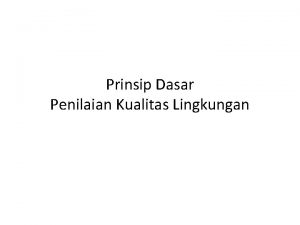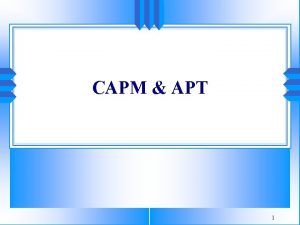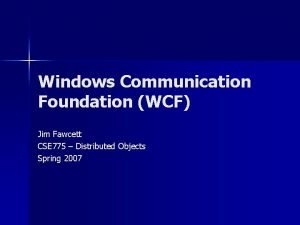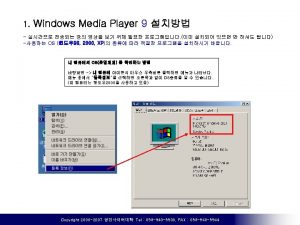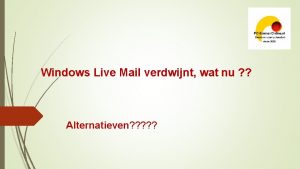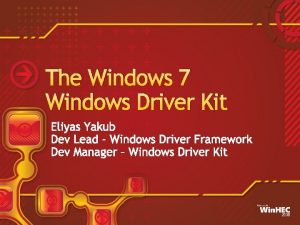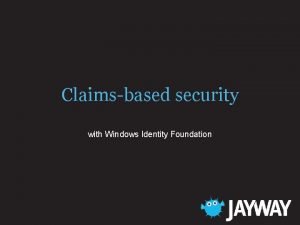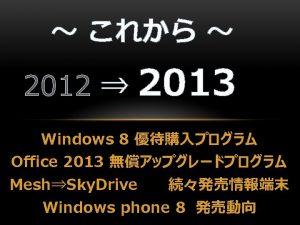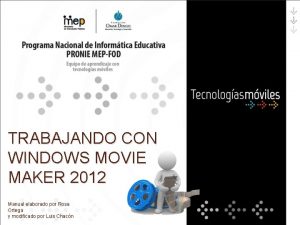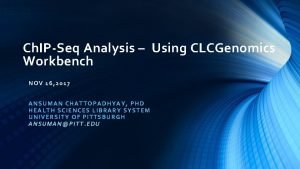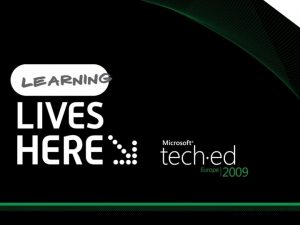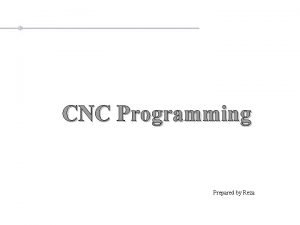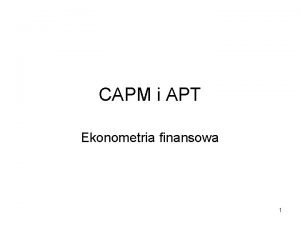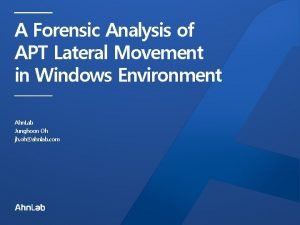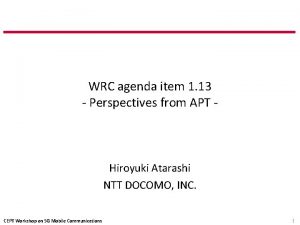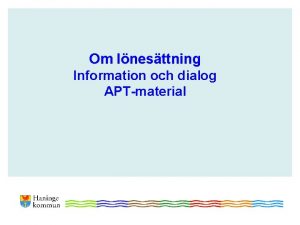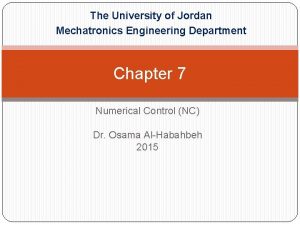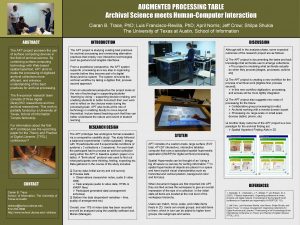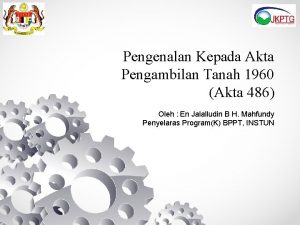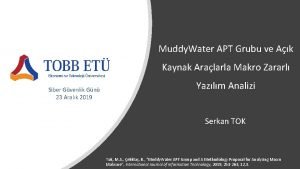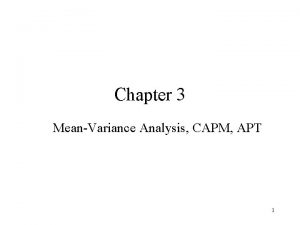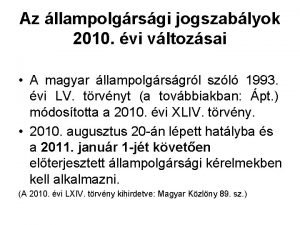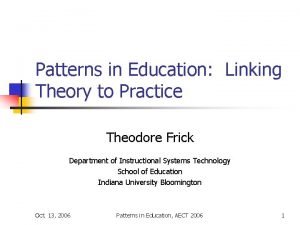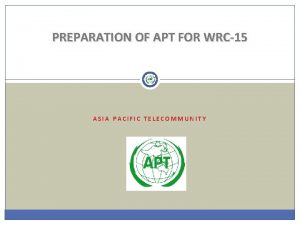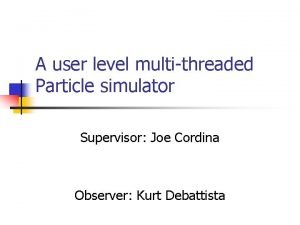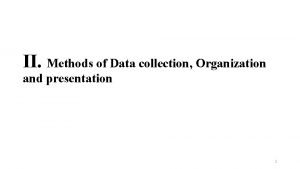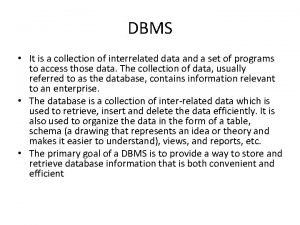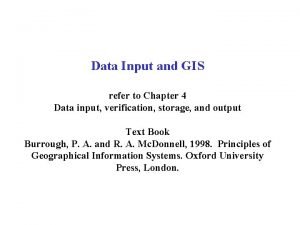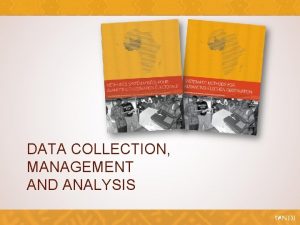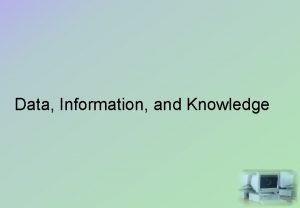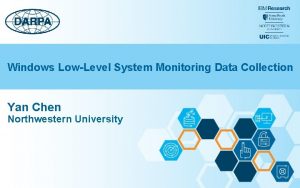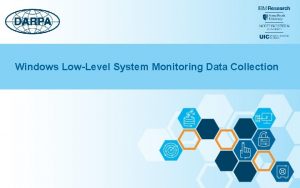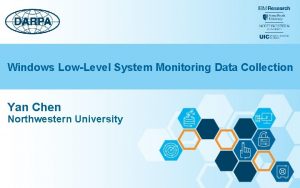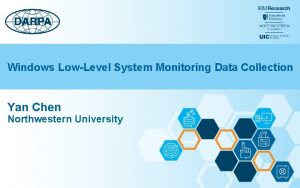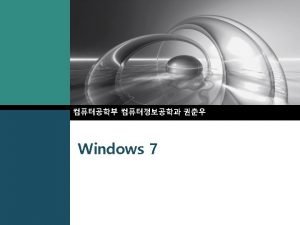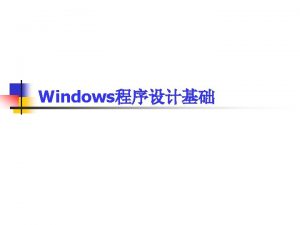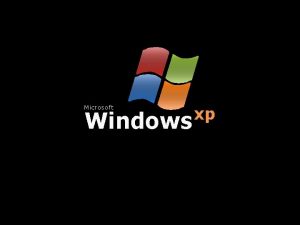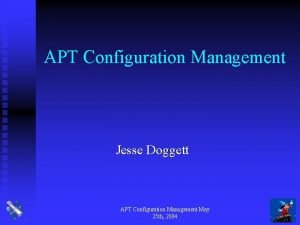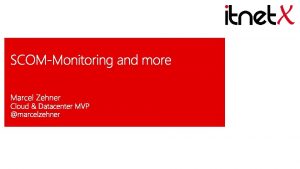Windows LowLevel System Monitoring Data Collection and APT




























































- Slides: 60

Windows Low-Level System Monitoring Data Collection and APT Detection Yan Chen and Runqing Yang Northwestern University

Outline § MARPLE TA 1 System Design and Implementation § MARPLE TA 1 Data Provided § MARPLE TA 2 APTShield Results for Engagement 4 § APTShield System Design § Future Work and Conclusions 2

Data Collection Overview § ETW is Robust, Lightweight, Built-in, Dynamic § Kernel Providers Used – Process, Thread – Registry – Network – File – Stackwalk –… 3

4

Correlate Call stacks with Events • Call stacks are provided by a separate ETW provider – “stackwalk”. • Call stack event contains “call address sequence” • Match the timestamp to correlate a call stack and a kernel event • The time complexity is negligible 5

Dealing with Performance Overhead There are too many call stacks (almost 10 x more than events), big performance overhead: • Parsing call stack to API name -- 1/3 of total time. • Serializing and sending API names -- about half of time. • We can barely achieve real time parsing full call stack So we only provide top API data. • Only parse one level of call stack and send one API name per event. • Makes the real time collection feasible 6

1: Windows Event Data from NT Kernel Logger Category Operations Process start, end Thread start, end File name, create, delete, enumeration, notification, set, rename, query, read, write, cleanup, close, flush Image load, unload, free Network accept, connect, disconnect, receive, reconnect, retransmit, send, fail, copy Stackwalk API function calls (for PHF detection) 7

2: API Data Provided, by Category (to be changed to PHFs) \Windows\Sys. WOW 64\ntdll. dll: Zw. Query. Information. Process System Information \Windows\System 32\ntdll. dll: Zw. Query. System. Information \Windows\System 32\Kernel. Base. dll: Get. System. Info \Windows\Microsoft. NET\Framework 64\v 2. 0. 50727\mscorwks. dll: Initialize. Fusion \Windows\Microsoft. NET\Framework 64\v 2. 0. 50727\mscorwks. dll: Cert. Create. Authentic ode. License Network \Windows\Microsoft. NET\Framework 64\v 2. 0. 50727\mscorwks. dll: Strong. Name. Token. Fr om. Public. Key \Windows\System 32\MMDev. API. dll: Dll. Get. Class. Object Audio \Windows\Sys. WOW 64\winmm. dll: mci. Send. String. W \Windows\winsxs\x 86_microsoft. windows. gdiplus_6595 b 64144 ccf 1 df_1. 1. 7601. 17514_ none_72 d 18 a 4386696 c 80\Gdi. Plus. dll: Gdip. Clone. Bitmap. Area. I \Windows\Sys. WOW 64\gdi 32. dll: Gdi. Release. DC Graphic \Windows\winsxs\x 86_microsoft. windows. gdiplus_6595 b 64144 ccf 1 df_1. 1. 7601. 17514_ none_72 d 18 a 4386696 c 80\Gdi. Plus. dll: Gdip. Get. Image. Thumbnail \Windows\winsxs\x 86_microsoft. windows. gdiplus_6595 b 64144 ccf 1 df_1. 1. 7601. 17514_ none_72 d 18 a 4386696 c 80\Gdi. Plus. dll: Gdip. Create. Solid. Fill \Windows\System 32\user 32. dll: Enum. Display. Monitors \Windows\System 32\user 32. dll: Set. Scroll. Info User Interaction \Windows\System 32\user 32. dll: Enum. Windows \Windows\System 32\user 32. dll: Get. Window. Text. W 8

Additional Security Related Data Collected Case Data Source User input (Keyboard and Mouse) Low-Level Windows Message Hooking Window Creation (invisible win) Traverse open windows with their properties Scan Microsoft Macros Use Ole. Tools library in Python we scan documents at creation/modification Power. Shell Command Recording Enabling user-level provider “Microsoft. Windows-Powershell” Binary File Certificate Calling Windows APIs to check for certificate on EVENT_LOADLIBRARY events 9

Comparison with Five. Directions MARPLE 5 D API √ × API & Event correlation √ × Thread Information √ √ User Level Events √ √ Additional security data √ limited Real-time Parsing √ √ Notes: 5 D is mainly user-level data, has to be saved to logs before reading from it. We read directly from providers, have no disk access (save resource, small load on the system). 10

Case Study : Keylogger Operations Process of Keylogging Data MARPLE TA 1 Data(API) Capture keystrokes Get. Key. State Get. Keyboard. Layout To. Unicode. Ex Capture foreground window information Get. Foreground. Window Get. Window. Text. W Get. Window. Thread. Process. Id Save results to file Write. File 5 D Data Missing Write. File 12

Case Study : Generalization • With our semantic-aware detection system, administrators can easily identify fine-grained semantic behaviors and understand consequences of the attack. 13

Case Study: Without Our System • Even if all artifacts left by the attack are captured, administrators still cannot understand consequences of the attack. 14

Challenges and Solutions for the Collector 1. 2. 3. How to parse callstack data efficiently? ▪ Use trees to keep module and API intervals ▪ Use LRU caches inside trees to increase speed when parsing sequential addresses Memory challenge: A lot of information to keep about the processes ▪ Delete the data we don’t need anymore (finished processes, closed network connections, …) ▪ We clear up object UUID mapping every 30 seconds, which may lead to a new UUID assignment to the same object. CPU overhead: Process huge amount of events ▪ Filter events to those useful for detection and forensic 4. Missing parameters in some ETW events • Correlate events to fulfill the missing ones 5. Network overhead • Combine multiple APIs related to the same thread as one CDM record. 15

Performance Evaluation • CPU-bound workload. The command line option of 7 -zip supports a simple benchmark, which mostly perform CPU-bound computation. • IO-bound workload. In this situation, we use 7 -zip to archive 3 folders including 73 files without compression. The total size of all files are 14. 7 gigabyte. This is purely IO-bound workload. • Mixed workload. In this situation, the same 14. 7 gigabyte files are compressed using 7 -zip. Compression and writing to disk reflect a more mixed case in which an application is performing CPU-bound computation and IO-bound tasks. Baseline With our collector CPU-bound workload 59 s(0%) IO-bound workload 250 s 255 s(2%) Mixed workload 165 s 168(1. 8%) 16

Outline § MARPLE TA 1 System Design and Implementation § MARPLE TA 1 Data Provided § MARPLE TA 2 APTShield Results for Engagement 5 § APTShield System Design § Future Work and Conclusions 17

Our Findings Summary v Attacks were conducted by TA 5. 1 during 2 days: 13 th (on MARPLE data), 19 th (MARPLE - TRACE data) n On Nov. 13 th: successfully detect four attacks in real-time. Corrected: 4% Corrected: 15. 3% Corrected Results haven’t been approved by Kudu 18

Our Findings Summary v Attacks were conducted by TA 5. 1 during 2 days: 13 th (on MARPLE data), 19 th (MARPLE - TRACE data) n On Nov. 13 th: n We missed exploitation because our system focuses on post-breach analysis instead of exploits. n However, our system can detect any malicious behaviors after compromising the Firefox, such as stealing high confidential documents, downloading malware, etc. 19

Our Findings Summary v Attacks were conducted by TA 5. 1 during 2 days: 13 th (on MARPLE data), 19 th (MARPLE - TRACE data) n On Nov. 13 th: n Two malicious executables which capture screen and record key stroke. n Powershell-based in-memory attack in which a malicious shellcode is loaded by using the DLL Injection technique. 20

Our Findings Summary v Attacks were conducted by TA 5. 1 during 2 days: 13 th (on MARPLE data), 19 th (MARPLE - TRACE data) n On Nov. 19 th: Combined Results: TRACE(2/32) + MARPLE(17/25) = 33. 33% 68% 21

Our Findings Summary v Attacks were conducted by TA 5. 1 during 2 days: 13 th (on MARPLE data), 19 th (MARPLE - TRACE data) n On Nov. 19 th: n Part of TA 1 collectors was killed by an attacker through SSH. n Reconnaissance and Data Leakage. Host information is collected and exfiltrated through SSH. 22

Policy Enforcement Results Summary Policy name Data set Result Originating User TRACE-MARPLE Passed the test except missing one userid. Remote Communication MARPLE-THEIA Not pass this test. User Interface Action MARPLE only Passed this test except missing two process name. Files Read And Origination Not tested and not run in the demo. MARPLE TA 1 has fixed the issue MARPLE-TRACE about EVENT_NAME, but BBN used the wrong version. There is no policy enforcement results in the final report of Kudu. 23

Attack Campaign 1 (on Nov 13 th ) Two suspicious executable files is downloaded and executed. n doit 2. exe is executed. n Keylogging and screengrab detected n Sending and receiving messages from 128. 55. 12. 185 on port 31337. n cloud. exe was downloaded and executed by firefox. n Screengrab detected. 24

Attack Graph for Campaign 1 IP: 128. 55. 12. 185 Port: 31337 25

Attack Graph for Campaign 2 26

Attack Campaign 3 (on Nov 13 th ) Attackers leverage Powershell to perform malicious actions. n A multi-layer obfuscated powershell script was downloaded and executed. n A malicious shellcode was loaded using the DLL Injection technique. n The shellcode connected to C&C server (128. 55. 12. 185: 31337). n Same IP and port used in the earlier attack 27

Attack Graph for Campaign 2 DLL Injection Reverse TCP Shell. Code 28

Details of obfuscated Powershell script First layer: raw obfuscated script The yellow string embedded in the script was first decoded by base 64 and then decompressed using Gzip. 29

Details of obfuscated Powershell script Second layer: deobfuscated script • The script leverage DLL Injection technique to load a base 64 encoded shellcode from memory. • DLL Injection was implemented through 2 key APIs: Virtuall. Alloc and Create. Thread. • Found to be similar to opensource powershell tool 30

Details of obfuscated Powershell script Third layer: shellcode The shellcode connected to C&C server (128. 55. 12. 185: 31337). 31

Attack Campaign 4 (on Nov 19 th ) Through SSH connection, an attacker executed cmd. exe which run several commands to locate processes of TA 1 collector: • • schtasks /query # query schduled task in Windows wmic qfe # query Windows Hotfix information sc query # query services in Windows tasklist # running process and process info(e. g. pid) Then the attacker try to kill the TA 1 collectors! 1) taskkill /PID 3764 /F # process (pid: 3764) is a part of collector 2) taskkill /PID 2192 /F # process (pid: 2192) is a part of collector Data Collection and Exfiltration: • A file C: WindowsSystem 32driversetchosts was exfiltrated through SSH. 32

Attack Graph for Campaign 4 SSH server cmd. exe commands 33

Outline § MARPLE TA 1 System Design and Implementation § MARPLE TA 1 Data Provided § MARPLE TA 2 APTShield Results for Engagement 4 § APTShield System Design § Future Work and Conclusions 34

Motivation Initial Compromise Gaining Foothold Lateral Movement High Value Asset Acquisition Malware (e. g. RAT) Phishing Exploit vulnerability Victim Attacker Malicious Web an ork sc w t e N Malw prop are agat ion Exploit browser Code Repo I F T N E L O D A C Database Low-level Behavior based Malware detection § Design a detection mechanism that targets at the postcompromise steps in the APT life-cycle. 35

Motivation v Traditional detection approaches focus on exploit part of the attack chain by using IOC(Indicator of Compromise). v High confidence IOCs, such as IPs and Malware signatures, help detect known attacks without obfuscations. v For stealthy APT, low confidence IOCs are needed, for example, suspicious behaviors, which may lead a large number of alerts. 36

Challenges: 1. Filter false positive alerts; 2. Aggregate a large number of alerts; 3. Recover the context information (e. g. , data flow and control flow) in real-time 4. Detect in real-time with low overhead; 37

Motivation v Context-based detection shows the real attack Standalone alerts: n One process is injected. n One process accesses After aggregation: sensitive files. n One process loads an uncertificated image. n An image file is downloaded. 38

System Details and Implementation v Problem 2 : Customized ASIs/rules/polices. n The framework is designed to be customizable to cover more attacks and adjust to different situation n n ASIs(Identifier, Confidence Score, Type, Description): n PT 2, 1, PHF, Access sensitive information n FT 5, 1, Data, The file contains sensitive information Rules(Subject, Event, Object/Subject, Direction): n n PT 2, 2, FT 5, R Policies: (Combination of Type) n PHF & Code. Source & No. Visible. Winodw & Network 39

Main Idea v A Context-Based Semantic-Aware Attack Detection and Reconstruction System v Atomic suspicious indicators (ASI) v Aggregation Framework (Rules) v Detection Policies 40

System Overview v Detect attacks by aggregating multiple ASIs 41

Basic Idea From MITRE Attack Matrix for Enterprise ASIs (Atomic Suspicious Indicators) are the semantic-aware indicators of an attack. Because there is no essential difference between the implementation of malware and of benign applications, these indicators often occur in benign application. Tactics Initial Access Execution Persistence Privilege Escalation Defense Evasion Credential Access Discovery Lateral Movement Collection Exfiltration Command & Control 42

System Design -- ASI v How to design ASIs: There are many tactics and techniques used in an attack life cycle, but they are not all necessary. v The essential parts of APT attacks: 1. Remote access to victims (including Malware download and VNC, etc. ); 2. Execution of suspicious behavior to achieve attack goals; 3. Network Connection (to exfiltrate or connect to C&C server) Meanwhile, other features, for example staying stealthy. 43

System Design – ASI detection with kernel monitoring Principle Category ASI Audio Recording Keylogger Remote Desktop Behavior Remote Shell Screen Grab Execute sensitive programs/commands Process Access sensitive information Code Source Load downloaded and uncertified images Reflective Loading Executing network script 44

System Design – ASI detection with kernel monitoring Principle Category ASI Without Human Interaction Without Visible Windows Process Features Heartbeat Executed automatically Network connections Contains data from network Code Source File Feature Contains Macro Uncertified Contains user data in default 45

System Design – Aggregation Framework v It is more efficient to aggregate the indicators than detecting with graph pattern matching. 46

System Design – Aggregation Framework v Rules are used to aggregate ASIs from one subject/object to another, thus collecting the context information. v A simple example of aggregation. 47

System Design – Aggregation Framework v Preliminary aggregation rule design 1. Data Flow: forward, which represents where the data from network, sensitive file and malicious behavior(for example, screengrab) gone; 2. Control Flow: backward, which represents the execution intention, for example, injection; 48

System Design v Detection Policy v Four Main Components of an attack life cycle: v 1. Execute codes/scripts from external attacker (or insider attack) v 2. Suspicious Behaviors: The target of the attack; v 3. Network Connections: To communicate with attacker and exfiltration data v 4. Other features: For example, stay stealthy. v The first three determines an attack while the 4 th adds more confidence score. v Fast Policy Matching, only one process node involved. 49

System Details and Implementation v Problem 1: ASI Signatures Training and Detection 50

System Details and Implementation v Problem 2: Attack Reconstruction n We’ve designed a ASI-based attack graph reconstruction approach. n If process A is found to be suspicious, our approach would explain the source of the ASIs in A. n Advantages: 1. Don’t use additional memory; 2. Fast; 3. Accurate in most scenarios. 51

System Details and Implementation v Problem 3: Data Storage in Memory n Instead of a graph, we prefer a process tree with a file list. n Process Tree n Each node is a process with its creation information and ASIs n n File List n n Nodes are connected by creation relationships. Each element is a file with its attributes and labels We don’t store events in memory, but status. 52

System Details and Implementation v Problem 3: Data Storage in Memory (cont’d) v Memory Usage in E 4 for one day: v 1122 processes, 132 KB v 10442 files, 625 KB v Status (ASIs, Relationships and additional data), 12. 45 MB v Strings (Process Name, Command Line and File Path), 35 MB 53

Conclusions n Design and implement a context-based semantic-aware APT detection system n n Atomic suspicious indicators (ASI) n Aggregation Framework (Rules) n Detection Policies Promising results on Engagement 4 as the First Attempt 54

Ongoing and Future Work v TA 1: Reduce the amount of event data v Summarize the APIs and only report its semantics v TA 2: Cross host analysis v TA 2: Get more complete picture of the attack process 55

DARPA BAA 15 -15 Transparent Computing: Project MARPLE Mr. Jacob Torrey / I 2 O PROGRAM OVERVIEW TA 1 Artifacts: Provenance Info PROGRAM OUTCOMES MARPLE Analytics: Real-time and forensic cyber threat discovery and analysis Reports: Real-time IOC detection • • Sketch-based Point Analytics Tag-based Detection APT Behavior Reconstruction Anomaly Detection using LSTM Fine-grained RAT Behavior Analysis Streaming Graph Anomaly Detection • • Real-Time Alerts Attack Description and Visualization Response for policy enforcement Capability Objectives: • Detect attacks that they current enterprise security tools are missing today • Detect existing attacks faster and earlier in the kill-chain life cycle • Formulate and implement a scalable enterprise-wide defense so that intelligence from one part of the network can be used enterprise-wide • Enable sharing of actionable threat and vulnerability intelligence with peer enterprises. Transition: • Potentially: DARPA/I 2 O and USG Agencies Program changes: None PROGRAM STATUS § Platform: – – Fast analytics • § τ-calculus: a DSL for security analytics Heterogeneous Information Network Mitigating APT Damage by Reasoning with Provenance in Large Enterprise Networks Automatic and Human-Guided Analytics: – § Sketch-based Point Analytics, SLEUTH, HOLMES, Stream. Spot, LSTM Anomaly Detection, PHF Modeling and Detection, and τ-calculus analytics Policy Reasoning and Response System – – – § MARPLE platform based on Feature Store and τ-calculus Space-Efficient Main Memory Representation of Provenance Graphs τ-calculus Policy Reasoning Module Tag-based Policy Reasoning Module General Graph Traversal Module 7 top-tier publications, multiple technical reports and disclosures 56

The End

System Details and Implementation v Problem 2 : Customized ASIs/rules/polices. n The framework is designed to be customizable to cover more attacks and adjust to different situation n n ASIs(Identifier, Confidence Score, Type, Description): n PT 2, 1, PHF, Access sensitive information n FT 5, 1, Data, The file contains sensitive information Rules(Subject, Event, Object/Subject, Direction): n n PT 2, 2, FT 5, R Policies: (Combination of Type) n PHF & Code. Source & No. Visible. Winodw & Network 58

System Details and Implementation v Problem 5: Cross-machine Detection v To do in the future. v All the memory increases linearly with number of machines. So we can handle all data in only one process. 59

Related Work v APT Provenance tracking and Forensics n n n Connect collected low-level events to build the causal graph among them. Similar with us, consider the complete APT attack process Assume a confirmed attack point to start with and usually have efficiency problem. v Malware Detection with system-wide information flow n n n Build behavior model using information flow surrounding malwares. Basically achieve real-time efficiency and use a relatively comprehensive behavior model(not only focus on behavior of one program) Suffer from high FP and various evasion attacks. 60

Related Work(con’t) v Alert Correlation n Correlate different alerts caused by a single attack to recover attack lifecycles and get more accurate detection result. Very similar high-level idea with us. (Aggregate alerts and perform better detection) Techniques used by most previous works are out of date and inefficient. • Plenty of techniques were proposed to solve whether two event is related which can be solved by causality monitoring today. • Not semantics-aware at all. It usually leads to bad detection result quality. 61
 Procedures of data collection
Procedures of data collection Landsat collection 1 vs collection 2
Landsat collection 1 vs collection 2 Clean collection vs documentary collection
Clean collection vs documentary collection Data collection secondary data sources
Data collection secondary data sources Prinsip dasar analisis kualitas lingkungan
Prinsip dasar analisis kualitas lingkungan Apt and capm
Apt and capm Windows event collection
Windows event collection Windows communication foundation wcf performance
Windows communication foundation wcf performance Wigos data quality monitoring system
Wigos data quality monitoring system Window movi maker
Window movi maker Windows 2000 media player
Windows 2000 media player Windows live mail windows 8
Windows live mail windows 8 Windows driver kit windows 7
Windows driver kit windows 7 Microsoft windows movie maker
Microsoft windows movie maker Skin for windows media player
Skin for windows media player Windows identity foundation windows 10
Windows identity foundation windows 10 Windws update
Windws update Free windows xp virtual machine
Free windows xp virtual machine Windows mobile center windows 10
Windows mobile center windows 10 Manual windows movie maker
Manual windows movie maker Windows vista windows 10
Windows vista windows 10 Xp mode key
Xp mode key The apt requires a benchmark portfolio
The apt requires a benchmark portfolio Single factor apt
Single factor apt Apt model
Apt model Apt programming examples
Apt programming examples Capm apt
Capm apt Apt teacher meaning
Apt teacher meaning Apt lateral movement
Apt lateral movement Apt agenda
Apt agenda Diskussionsfrågor till apt
Diskussionsfrågor till apt Apt wtdc
Apt wtdc Apt language
Apt language Werner louis apt baruch
Werner louis apt baruch Apt-s study skills framework
Apt-s study skills framework Multifactor apt formula
Multifactor apt formula Augmented processing table adalah
Augmented processing table adalah Kelebihan dan kekurangan apt
Kelebihan dan kekurangan apt Warta seksyen 8
Warta seksyen 8 Werner louis apt baruch
Werner louis apt baruch Werner louis apt baruch
Werner louis apt baruch Muddy water apt
Muddy water apt Apt
Apt Capm apt
Capm apt Egyszerűsített honosítás nyomtatvány
Egyszerűsített honosítás nyomtatvány Apt case study
Apt case study Apt code
Apt code Werner louis apt baruch
Werner louis apt baruch Placental migration
Placental migration Asia pacific telecommunity
Asia pacific telecommunity Apt ept root words
Apt ept root words Farmakologi uterotonika
Farmakologi uterotonika Apt asia pacific telecommunity
Apt asia pacific telecommunity Apt assumptions
Apt assumptions Apt multithreaded
Apt multithreaded Collection organization and presentation of data
Collection organization and presentation of data Collection of interrelated records is called
Collection of interrelated records is called Collection and analysis of rate data
Collection and analysis of rate data Data entry in gis
Data entry in gis Data collection management and analysis
Data collection management and analysis Data raw facts
Data raw facts




